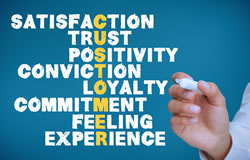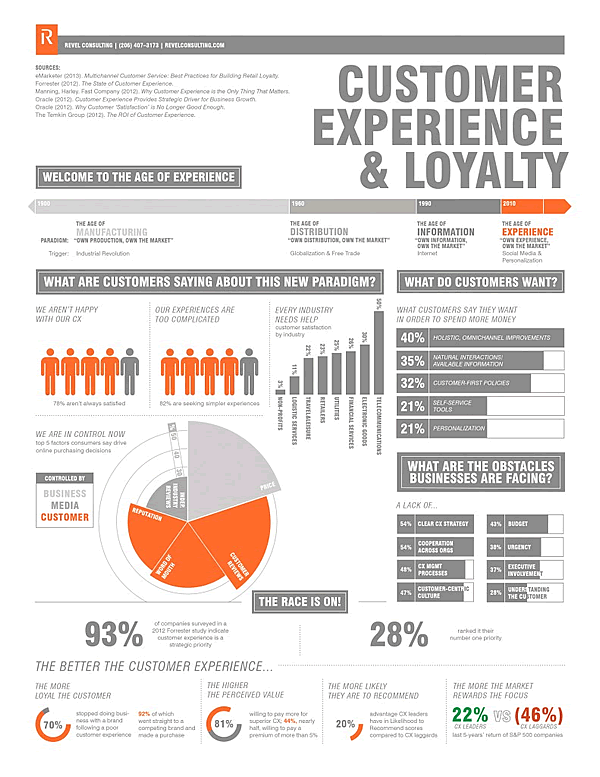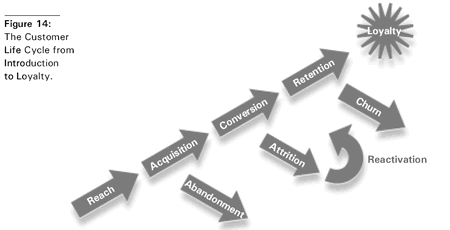 Customer loyalty is still looked upon as a holy grail in customer relationship management and marketing. We want loyal customers as they don’t just have a strong connection with our company and buy more, sometimes even willing to pay a premium, but also because they are prone to become true brand advocates.
Customer loyalty is still looked upon as a holy grail in customer relationship management and marketing. We want loyal customers as they don’t just have a strong connection with our company and buy more, sometimes even willing to pay a premium, but also because they are prone to become true brand advocates.
That’s the theory. But how loyal are customers really? And can you even be loyal to a brand or business? After all, the word loyalty implies a sense of faithfulness, dedication, passionate belief, adherence, trust, commitment, conviction, a lot of emotion, allegiance and/or even devotion. Can we be/have loyal customers in that sense? And what about the fact that customer loyalty has been clearly on the decline, certainly among the so-called digital customers – those that tend to use digital platforms and tools most as we’ll cover further in this overview?
Confusions and misunderstandings about customer loyalty
We often see that the concept and whole idea of customer loyalty has lost its original meaning a bit, leading to various ‘confusions’.
Confusing brand advocacy with customer loyalty.
Sometimes brand advocacy and customer loyalty are treated as synonyms. However, a loyal customer is not necessarily an advocate and the other way around (we’re being very strict now) a brand advocate is not ALWAYS necessarily a customer . Example: it’s not because you’re a huge fan and advocate of a very expensive fashion brand that you actually have the means to buy their clothes. Customer loyalty is also not the same as brand affinity. On the other hand, there is a strong link between customer loyalty and advocacy as we’ll cover further.
Confusing customer loyalty and customer retention.
This is probably where we see most confusion: in narrowing down customer loyalty to retention. Admittedly both are somewhat overlapping but there is a distinction. And even customer retention is up for debate. When do you ‘keep’ a customer? In services with annual renewal fees it’s easy to see: the customers you keep (retention) are those that renew their contracts (no churn). But what about a customer of a supermarket who buys at several supermarkets? He is not loyal. And have you really kept him as a customer if he only buys sporadically and turns out to buy more at other supermarkets? That’s why the type of business, timing, frequency and other contextual elements are often taken into account to define customer retention (and loyalty) for any particular organization. And it’s also why we typically distinguish between different types of “loyal customers”.
Confusing loyal customers and customer loyalty programs
Look it up: a huge percentage of information you find when you want to know about customer loyalty is really about customer loyalty programs. While such programs, if properly designed and executed contribute to loyalty, many don’t and in the end often become rebate programs, breeding/nurturing anything but loyal customers – and often even leading to less profit if the program is so focused on rebates that in the end no one pays the full price anymore.
Confusing satisfaction, service and experience
Last but not least, it’s important not to confuse customer loyalty with customer satisfaction which is merely a (relatively) driver and small indicatorof it. Furthermore, customer loyalty is not just a matter of customer service or the contact center nor is it the same or only the result of a good end-to-end customer experience or individual satisfying, let alone ‘amazing’, experiences across various possible touchpoints and the full customer life cycle. On the other hand, the customer experience and customer engagement are becoming more important in a context of customer loyalty today as we’ll tackle further.

Why everyone wants loyal customers
Why are customer loyalty (and retention) so important if it’s far from easy to define what loyalty means and should be, let alone classify your customers this way (true: sometimes it is easier as mentioned and if you take into account your own business and customer context it can be done)?
The main reason is obviously that loyal customers are worth gold. They don’t only buy repeatedly, they also stick around and have an emotional value connection, often bringing others in the ‘influence sphere’ of your business or even turning them into customers themselves. Imagine: people who pay to buy your products and in a sense are also part of your sales team!
And the reason why we focus on customer retention is well-known too: it’s simply expensive to acquire new customers and making sure your existing customers stick around and buy more is often more cost-effective.
Yet, as said in the introduction, confusion tends to reign when it concerns customer loyalty and the face of customer loyalty is changing as are the ways to achieve it.
Bringing in the emotional attachment factor
Over the years there has been a shift in the ways we look at customer loyalty. The traditional views of boosting customer satisfaction and making customers happy so they became loyal don’t cut it anymore – if the ever did to start with.
Gradually the focus has moved from these satisfaction-related ways of looking at customer value (as value for the customer and customer through the loyal customer in a lifetime value perspective) to recommendation likelihood (more below), actual customer engagement and customer experience (both are not the same).
Contrary to popular belief this shift of focus is not new (nor is the concept of customer engagement) and certainly isn’t due to the arrival of the ‘digital customer’ whom we call more empowered and who is typically less loyal (even if in recent years things have changed faster).
In fact, already in 2001, William J. McEwen wrote a piece titled ‘Beyond Customer Loyalty‘. McEwen wondered why, despite all the investments made to increase customer satisfaction, it turned out that satisfaction scores (back then the key metric) didn’t improve.
He found many reasons for this phenomenon. We point out two that are related.
New ways of measurement were needed and satisfaction alone is far from enough to measure the (strength of the) relationship with the customer. Metrics based on satisfaction gauge emotions at a specific point in time or regarding a ‘current choice’ but as such it is just a small piece of how loyalty can be measured as it says little about future intent or loyalty for that matter.
McEwen brought in engagement and emotional attachment instead of satisfaction (alone). Probably the most important conclusion, based upon Gallup research, was indeed that an essential ingredient in the customer relationship was overlooked to gauge the strength of a customer relationship: the emotional ingredient, not in the sense of satisfaction but in the sense of emotional attachment.
Today (and still) we take it for granted that emotions are essential in building customer loyalty and it’s not a coincidence that emotions are also essential in customer engagement and customer experience management. Around the same time the article was published, many experts on customer loyalty started emphasizing emotional attachment as being a key component and most still do today.
Customer loyalty and brand advocacy: from satisfaction to NPS
In 2003 Frederick F. Reichheld of Bain & Company published a report with the results of a study, that would have a significant impact on the attention for recommendations, word-of-mouth marketing, customer loyalty and the role that good customers can play in ‘promoting’ your company and products.
The report, called ‘The One Number You Need to Grow’, which introduced NPS (Net Promoter) as a measurement ‘alternative’ also led to one of the most used concepts today in that context: ‘brand advocacy’.
To better understand what it means, let’s take a look at the customer life cycle and another influential publication, dating from 2000, that was written by Jim Sterne and Matt Cutler and was called “E-Metrics, Business Metrics For The New Economy” (PDF opens).
Cutler and Sterne introduced a (now somewhat refined) model of the customer life cycle with five steps: 1) reach, 2) acquisition, 3) conversion, 4) retency and 5) loyalty. It’s in the context of the loyalty stage that we use the term ‘brand advocacy’ and ‘brand advocates’.

Loyal customers are, first of all, customers who come back to us often and remain customers. However, in the view of Sterne, Cutler and Reichheld, they are mainly customers that recommend our brands, products and companies to others.
In his publication, Reichheld suggested that measuring the loyalty of customers is easy: ask your customers how likely it is that they recommend your company to friends. Net Promoter Score indeed. This simple question was further developed by him in his report that clearly showed the power of recommendations by loyal customers. Reichheld called these customers ‘promoters’: loyal customers that would very probably recommend the company (with a certainty between 9 and 10, on a scale of 10).
An obvious question, that Reichheld also answered, was “how do I make promoters of my customers?”. Since the publication of the report, several authors and studies emphasized that brand advocacy is a greater indicator of (future) business growth than, for instance, your brand perception.
The decline of customer loyalty and the growing role of customer experience and engagement
It is often said that customer loyalty is on the decline. And it indeed is. Today’s customers are less loyal than ever before. However, what are the causes of this evolution?
Again contrary to popular belief the decline of customer loyalty is not just because of the advent of the ‘increasingly digital customer’ although research shows that the ‘more’ digital customer is less loyal than others.
Matthew Dixon of the CEB, the inventors of another measurement method, the Customer Effort Score, tackled it in our interview and several other companies found the exact same thing across various industries.
Knowing the strong emotional dimension of customer loyalty there seems to be a correlation between trust and loyalty as is the case in any relationship whatsoever. So it’s probably not a surprise that customer loyalty declined during the last big recession when consumer trust in many industries declined sharply as well.
After the recession research after research found that customer loyalty didn’t return to the same levels as before. With trust being key in any business relationship it led to more research into the reasons of this phenomenon and of the role of trust in customer relationships. As a study (PDF opens) by the ESCP Europe Business School (Prof. Chris Halliburton and Adina Poenaru) in 2010 stated “The main benefit of trust is customer loyalty, which in turn leads to a longer term relationship, greater share of wallet, and higher advocacy or word-of-mouth”.
In 2009, the CMO Council and Pointer Media Network released a study “The Consumer Defection Dilemma“. The research looked at brand loyalty and defection among American shoppers in the CPG industry and found a high level of loyalty churn affecting brands. For the average CPG brand in the study only 48% of high loyal consumers in 2007 remained high loyals in 2008 and one-third of all high loyals completely defected from the average brand in 2008. We have seen equally impressive findings in other research across other industries and in more recent years.
In this day and age of declining customer loyalty, in some cases even close to zero, it’s clear that many other evolutions, on top of the recession, have contributed and continue to contribute to declining loyalty overall.
It even leads some to totally abandon the concept of loyalty and dismiss it as a myth. Without a doubt the increasing attention for customer experience and customer engagement goes hand in hand with this decrease.

By way of illustration, the Google Trends chart below leaves little room for interpretation even if we must add that customer experience (management) and customer engagement are increasingly adopted by all sorts of software and solutions vendors and Google Trends is nothing more than an indicator.
Top image purchased under license from Shutterstock

